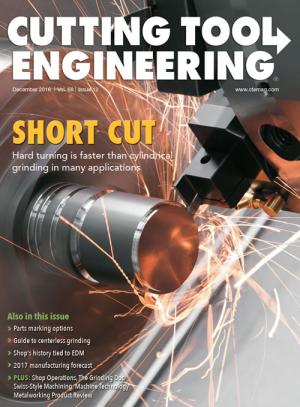There was plenty to see, eat, drink, hear and learn at the United States Cutting Tool Institute’s 2016 Fall Meeting, held in New Orleans Oct. 15-17.
As a former resident of southern Louisiana, I already knew the best places in the Crescent City to sightsee (Lower Garden District), eat (any po’boy stand) and imbibe (Napoleon House). And like any visitor to the city, I encountered funky, joyous music at every turn.
My favorite learning moment was the USCTI dinner held at the National WWII Museum. Visitors experience World War II through the words of world leaders, military personnel, citizens and manufacturers who supported the war effort. Stunning photographs and film clips supplement their stories.
The USCTI meeting also featured engaging speakers, including Jeff Rizzie, Sandvik Coromant Co.’s senior manager of business development. He discussed the need for machine shops to embrace digital technologies in order to optimize their manufacturing processes.
The “way we in manufacturing optimize our processes today is the same way we did when I went to work [as a machinist] 36 years ago: with stopwatches and clipboards,” Rizzie said. For continuous process improvement to occur, all phases of a shop’s operation—from design to machining to outbound logistics—must exist as a single thread on which information travels forwards and backwards. This allows personnel to assess processes with fresh eyes and remove obstacles to productivity instead of devising workarounds.
“We have become so clever at working around problems that we don’t see that they’re problems anymore,” Rizzie said. (To learn more about Rizzie’s thoughts on the digital machine shop, check out the MakingChips podcast at www.makingchips.com/mc074.)
Another compelling speaker was retired U.S. Navy Commander Eric Potterat, who served 10 years as a Navy SEALs psychologist. His practice and research focused on stress reduction, mental-toughness training, operational readiness and personnel selection. He said that when assessing the suitability of a prospective SEAL, the Navy looks for individuals with grit.
“Grit is more important than talent,” said Potterat, who believes grittiness is a characteristic company managers should seek when hiring employees. “I would ask [SEAL candidates] to tell me the most difficult thing they’ve ever done and how they handled it. I didn’t care what the difficult thing was. I wanted to know how they responded to it.”
Federal Reserve Bank of Chicago Senior Economist William Strauss addressed USCTI members, too. Strauss, who also contributed to CTE Senior Editor Mike Anderson’s forecast article that begins on page 44, projects the country’s gross domestic product will grow around 2 percent in 2017.
“The good news is that we’re looking at growth to continue,” Strauss told Anderson, adding that the current expansionary phase is entering its eighth year. “But, that being said, we’re not exactly setting the world on fire.” He expects U.S. manufacturing to grow 1.7 to 2 percent next year.
Other sources cited in the article concur. A couple forecast that the aerospace and automotive industries will outperform other manufacturing sectors in 2017.
How manufacturing fares next year will depend on known and unknown factors. The latter include energy prices, China’s slowing economy and the new administration.
Hopefully, the factors will play out in such a way as to “let the good times roll,” to use an old New Orleans saying.


